
Construction crews are currently demolishing the East Wing of the White House to pave the way for President Trump's ambitious $300 million, 90,000 square-foot ballroom. This significant renovation project has sparked considerable backlash from historical preservation groups and has proceeded without the necessary federal approvals. In response to the mounting criticism, the Trump administration has issued a fact sheet describing the project as a continuation of the long-standing tradition of renovations at the executive residence.
The White House has dismissed the reactions from critics as "manufactured outrage," asserting that the addition of a grand, privately funded ballroom is a pivotal enhancement that aligns with the storied history of improvements made by past presidents. According to the White House, this addition is necessary to maintain the executive mansion as a symbol of American excellence. Notably, Priya Jain, chair of the Society of Architectural Historians' Heritage Conservation Committee, noted that this ballroom would represent the largest addition to the White House since the 1940s, highlighting the project's unprecedented scope and size.
The White House has undergone numerous renovations since its inception in 1792. The original cornerstone was laid by President George Washington, who selected the site for the neoclassical building designed by James Hoban. Throughout the years, various U.S. presidents have made significant changes to the property, but none have been as extensive in recent history as the current demolition and construction project.
President John Adams and his wife Abigail were the first to inhabit the White House in 1800, even before its completion. Following a devastating fire during the War of 1812, which resulted in considerable damage, President James Madison oversaw the rebuilding process, with the second version of the White House reopening in 1817. Significant additions, such as the South Portico and North Portico, were introduced under President James Monroe and President Andrew Jackson, respectively.
Major renovations continued through the 20th century, particularly under President Theodore Roosevelt, who officially named the building the "White House" and initiated a comprehensive renovation in 1902. This project included relocating the president's office to the newly established West Wing, a move that significantly modernized the building. Subsequent presidents further expanded and remodeled the West Wing, culminating in President Franklin D. Roosevelt's addition of the East Wing in 1942.
The East Wing was constructed during a time of war, generating controversy over its cost and necessity. President Harry Truman's extensive renovations in the late 1940s included gutting the interior and adding the Truman Balcony, which faced its fair share of criticism but has since become a beloved feature of the White House.
In recent decades, presidents have made numerous alterations to the White House grounds, although these have generally been less extensive. For instance, President John F. Kennedy established the contemporary Rose Garden in 1963, which has seen modifications under subsequent administrations. President Barack Obama adapted space for basketball and First Lady Michelle Obama introduced the White House Kitchen Garden.
Since the beginning of his second term in January, President Trump has made a series of renovations, not just limited to the Rose Garden. His changes include lavish updates to the Oval Office and the introduction of a Presidential Walk of Fame. This new feature honors every president except for Joe Biden, whose portrait has been replaced with a picture of an autopen, a move Trump has criticized.
The White House maintains that these renovations are part of a proud tradition of enhancing the building's capacity for hosting significant functions, as current facilities often require large outdoor tents for events. However, experts, including Kate Andersen Brower, have expressed concerns about the scale of the ballroom project, questioning whether such an extensive addition is necessary.
As the demolition of the East Wing progresses, the debate over the renovation continues, reflecting a broader conversation about the balance between preserving historical integrity and modernizing important national landmarks. The outcome of this project and its implications for the future of the White House remain to be seen, but it undoubtedly marks a significant chapter in the ongoing narrative of the executive mansion's evolution.